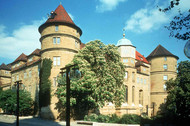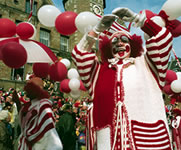Other highlights
Contact
Touristik - Information "i-Punkt"
Königsstrasse 1a
70173 Stuttgart
Email:
info@stuttgart-tourist.de
Internet:
www.stuttgart-tourist.de
Königsstrasse 1a
70173 Stuttgart
Email:
info@stuttgart-tourist.de
Internet:
www.stuttgart-tourist.de
Museums

Situated in the heart of the city, Stuttgart's Old Palace, once the seat of the counts and grand dukes of Baden-Württemberg, is now home to Württemberg Regional Museum. The museum traces the history of the region, documenting a period spanning the Stone Age, Celts, Romans, Alemanni, Middle Ages, baroque and modern age. At the heart of the exhibitions is the Kunstkammer, which dates back to the 16th century, when the dukes collected all manner of priceless curios. Other attractions from the former kingdom include crowns, sceptres and dazzling royal jewellery. Closed on Mondays, guided tours available.
» www.landesmuseum-stuttgart.de
Established in 1987, the "House of History" is part of the Stirling Wilford ensemble in Stuttgart's cultural district. Across several exhibition floors, it charts the fascinating history of the three historical states of Baden, Württemberg and Hohenzollern in south-west Germany. The exhibits are vividly presented in eight ultra-modern sections that explore the past 200 years of the region. Around 50,000 items make up the collection, including objects from Stammheim, the prison made famous in the 1970s by the Red Army Faction terrorists. Closed on Mondays. Guided tours available.
» www.hdgbw.de
Named after its founder Karl Graf von Linden, the Linden Museum in Stuttgart is one of Germany's biggest ethnological museums. Split into five large sections (Americas, South Pacific, Africa, the Islamic Orient, South and East Asia), the permanent exhibition covers non-European people and cultures from several continents. Special attractions include a Tibetan temple, a Japanese teahouse and an Oriental bazaar. With several special exhibitions throughout the year, guided tours and excursions around the globe, the museum offers an insight into the historical and cultural developments as well as the economic, social and religious factors affecting the lives of people on every continent in a variety of ways. Disabled facilities, closed on Mondays, guided tours available on request.
» www.lindenmuseum.de
The story of Porsche is almost as old as automotive history itself, beginning at the end of the 19th century with a design by Ferdinand Porsche (1875-1951). To the delight of fans from all over the world, the Porsche Museum opened in 1976 within the grounds of the Zuffenhausen factory. On a rotating basis, it displays 20 vehicles from a 400-strong collection of these super-fast cars. This includes the legendary 356 roadster and its 20 subsequent variants. There are also frequent special exhibitions, offering an insight into the company's history and the rise of Ferdinand Porsche's famous sports cars, the first of which rolled off the production line in 1936. This automotive dreamland takes visitors back to the Golden Age of motor racing, and shows how the invention of the car has shaped mankind and the environment more than any other technological advance. Right next to the museum is the factory's very own handover centre, where you can see proud owners driving off their brand-new Porsches. Open all year round.
» www.porsche.com
Dating back to the natural history specimens collected by the dukes of Württemberg in 1791, the State Museum for Natural History in Rosenstein Palace has a long tradition and is one of the foremost scientific collections in Europe. In addition to mammals, the museum also has a large number of beetles and butterflies. Designed with great attention to detail, the exhibition area offers an insight into the diversity of life on earth. As well as a large insect collection, there is a spectacular original skeleton of a Sei whale with inner organs. A separate exhibition area houses a walk-through, three-dimensional "classification book" for indigenous animals. Visitors can discover and explore a variety of different habits - from forests, moors and fields to crags, all of which have been reconstructed in realistic detail. Closed on Mondays. Guided tours available.
» www.naturkundemuseum-bw.de
Mercedes-Benz World was opened to coincide with the World Cup in 2006. Located just outside the Daimler-Chrysler factory in Stuttgart, it brings over 110 years of innovative automotive history to life. With 9 floors and a total exhibition space of 16,500m², the museum is a showcase for the pioneering days of the automobile. Exhibits include the world's first cars produced by Karl Benz and Gottlieb Daimler, the first Mercedes (naturally) and 160 other illustrations of the legendary Mercedes brand. Among the highlights are the "Silver Arrow", which made motor racing history, and Mercedes-Benz's commercial vehicles. Audio guide tours and guided tours available. Closed on Mondays.
» www.mercedes-benz.com
The Wilhelma Gardens in Stuttgart - a large, traditional zoo - were opened in 1850 and are the only combined zoological and botanical gardens in Europe. Built by the architect Karl Ludwig von Zanth (1796-1857) for King Wilhelm I of Württemberg as a Moorish-style summer house with living quarters and ornamental hothouses, many of the original buildings still remain. There is plenty to see, with around 9,000 animals (almost 1,000 different species), display beds and greenhouses, important orchid collections, an aquarium with crocodile house and a famous coral fish collection, a modern ape house, a bear enclosure, a walk-through free-flight aviary, a visitor farm and much more. Disabled access. Feeding demonstrations and animal shows, guided tours for groups available on request.
» www.wilhelma.de
The Weissenhof housing estate is one of the foremost examples of modern architecture. It was built for the exhibition of the German Work Federation in 1927. Under the artistic direction of Ludwig Mies van der Rohe, 17 architects from five countries created the template for an international-style residential estate for modern city dwellers. Attention was focused on Le Corbusier who worked with Pierre Jeanneret to build two semi-detached "residential machines" that are supported on posts and appear to float above the slope. Since 2006, this building has been home to the Weissenhof museum of architectural history. One half of the building houses an exhibition on the history of the housing estate, while in the other, visitors can walk around the Le Corbusier house and see what it originally looked like in 1927. It represents the whole estate, which consists of 21 houses with 63 apartments. Closed on Mondays. Guided tours on request.
» www.weissenhof-museum.de
Uhlbach is the place for those who know and love fine wines. The Viticulture Museum opened in 1979 in the former village wine press building, dating from 1907. On display is an extensive collection of objects from more than 750 years of local winegrowing tradition. A complete cooper's workshop gives an idea of work in the 18th and 19th centuries. Some exhibits even date back to the time of the Romans, such as drinking vessels and wine receptacles made of tin, clay and stoneware. There are also wooden barrels, certificates, a collection of corkscrews and a depiction of Pope Urban, the 16th-century patron saint for wine-growers. Text and pictures illustrate grape varieties, pest control, the harvest and vineyard consolidation. Open from April to October on Saturdays, Sundays and public holidays.
» www.stuttgart-tourist.de/DEU/freizeit/weinbaumuseumaltekelter.htm
Opened in 1998, the Bible Museum in Stuttgart's Bibelhaus presents a permanent exhibition about the book that is more widely read and has been translated into more languages than any other – the bible. It also features information about the history and significance of the bible on our lives. There are bibles from the Middle Ages, when books were first printed, from the period of Reformation and even electronic bibles. In addition to the vast collection of fascinating information about the history, tradition, translation and worldwide importance of the bible, all presented as conventional museum-style exhibits, visitors can also “hear, smell and feel” the bible thanks to the new interactive approaches. The exhibition includes a nomad tent, where you can smell frankincense and myrrh, listen to biblical stories with oriental sounds in the background, all under a starry sky as if you were in Jerusalem. Closed on Saturdays and Sundays. Guided tours on request.
» www.dbg.de
Travel Planner
Select an option...
Map of Germany
Hotels in Stuttgart
Loading



